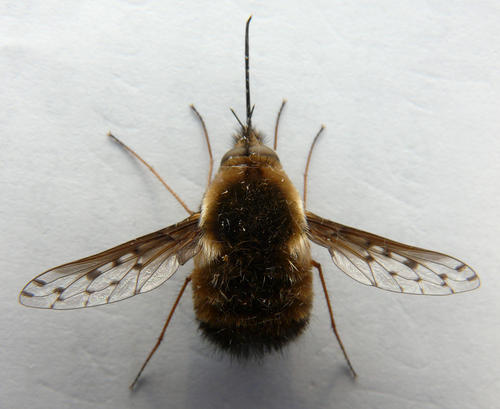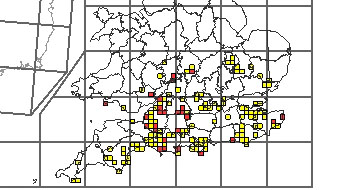Dotted beefly Bombylius discolor in southwest Worcestershire
Martin Skirrow
Hitherto there have been only three Worcestershire records for the Dotted Beefly Bombylius discolor, all around Bredon Hill: Kemerton in the south in 2004 and two near Beckford in the SE in early 2006 and 2007 (Worcestershire Record, No 21, Nov 2006; No 22, April 2007). At my home on a farm in Berrow, about 20 km west of Bredon (SO 778339) I was lucky to catch a B. discolor (photo) on 28th March 2011 where it was flying low and feeding on the flowers of Ground Ivy Glechoma hederacea. It was at about 16.00 h on a moderately warm afternoon with hazy sun. Harry Green, in his article in the Worcs Record No 21, cites Stubbs & Drake (2001) stating that a temperature of over 17oC is required to enable this species to fly. This might have been the temperature near the ground, but I doubt whether the general air temperature was as high as this (alas I have no firm readings).
The area in question, which borders a stream, had recently been cleared of rough growth and brambles, and a line of hazel trees had been coppiced. Numerous low plants are beginning to flower in the area, notably ground ivy, cowslips, and violets Viola reichenbachiana; V. odorata. The soil at the farm is a slightly acid heavy clay and most of its 55 acres consist of meadows, several of which are unimproved and species rich. The hosts of the parasitic larvae of B. discolor are mining bees that favour short turf and bare ground, mainly Andrena flavipes but also A. cineraria. I have found the latter here, but not the former, although I have not looked specifically for it.
(Postscript: Another Bombylius discolor nearby on 6th April in the afternoon feeding on hyacinth flowers)
Reference
Stubbs, A.E. & Drake, M. 2001. British soldier flies and their allies. British Entomological and Natural History Society, Reading.
Images
Fig. 1 Dotted beefly Bombylius discolor caught at Berrow. Picture ©Martin Skirrow.
Fig. 2 Bombylius discolor distribution according to the NBN March 2011. Red are records 1990-2010, yellow indicates earlier records. Resolution is 10x10km squares with vice county boundaries and 100x100 km squares indicated.

